Bone typically appears white or slightly yellow, but fossils differ and display a variety of colors: some fossils are grayish-white, some are yellowish or even black, and others exhibit multiple colors.
Before delving into this topic, we first need to understand how fossils are formed. Remains, such as bones and footprints of deceased animals, are quickly buried by sediments (like sand or volcanic ash), leading to the complete decomposition of organic materials. What remains are bones, shells, teeth, etc., which, over time, along with the surrounding sediments, become compacted into rock. At the same time, the original components are replaced by minerals; these ancient biological remnants are known as fossils.
The color of fossils is directly related to the burial environment, with the main causes of different colors being mineral dispersion, mineralization, and other coloring factors.
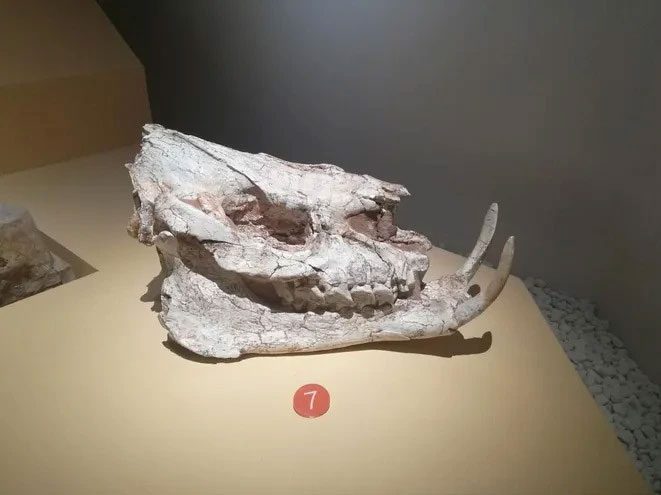
Fossil of a woolly rhinoceros skull.
Mineral Infiltration
Bones are generally white because their main component is calcium carbonate. Due to the relatively short fossilization time of Quaternary animal bones (2.58 million years, compared to the history of life on Earth), many bones have not been significantly affected by the burial environment and thus remain white or slightly yellow. For example, the fossilized mammal bones found at the Jinniushan site in DIng Kou, Liaoning, China, dating back 210,000 to 300,000 years, still retain a white color.
The fossilized skull of the woolly rhinoceros from the Linxia Basin in Gansu, China, has a white surface and is filled with clay minerals. It lived during the late Miocene, approximately 12 to 5 million years ago.
The shells, bones, or teeth of some ancient organisms buried underground may have manganese or iron oxides adhering to their surfaces or penetrating the spaces between bones and teeth, displaying colors such as yellow, brown, dark brown, and black.
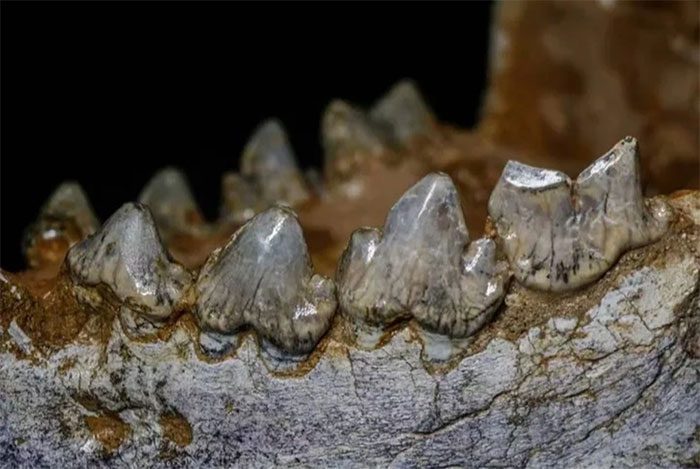
Black stains can be seen on the fossilized teeth of a giant hyena, resulting from iron and manganese pollution.
Mineralization/Metamorphosis
Mineralization or metamorphism is the primary mechanism through which animal fossils are formed: solutions containing minerals infiltrate the spaces within the organism’s body, leading to mineralization and making the tissues harder. Depending on the different minerals present, it can be categorized into silicification, opalization, pyritization, calcitization, etc.
Silicification
Petrified wood is relatively common, formed by replacing the original plant tissues with silicon dioxide (SiO2), retaining the original structure and shape while its internal nature has been entirely transformed. Different regions exhibit various types of petrified wood; the main component of petrified wood in Myanmar is opal (SiO2·nH2O), also known as “gem tree,” a popular ornamental stone.
Petrified wood comes in various colors due to the presence of other elements; iron can give the wood red, brown, milky white (opal), colorless (crystal), smoky gray, black, and other hues.
Petrified wood from Myanmar, once polished, appears milky white, brown, and reddish, resembling wood, but is actually fossilized.
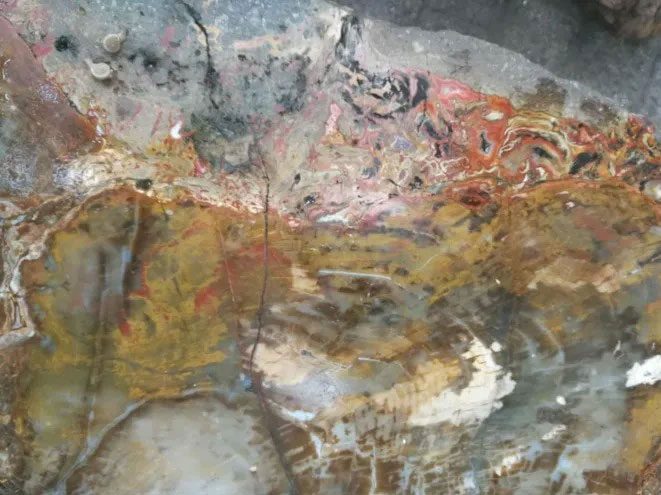
Petrified wood.
Opalization
Opalization is essentially a special form of silicification. Opal has a chemical composition of SiO2·nH2O. Opal is an amorphous gemstone formed from gelatinous or liquid silica that flows into cracks and cavities in the Earth, subsequently depositing and solidifying into a gemstone.
Opal appears in a variety of colors, from blue to green and yellow to orange and red, with its color variations attributed to its unique internal structure.
Pyritization
Liquids containing pyrite (FeS2) infiltrate the animal’s interior, evaporating water and crystallizing pyrite, resulting in fossilized remains pyritized, primarily including ammonites, belemnites, sea urchins, trilobites, and other marine animals, which have been affected by environmental issues.
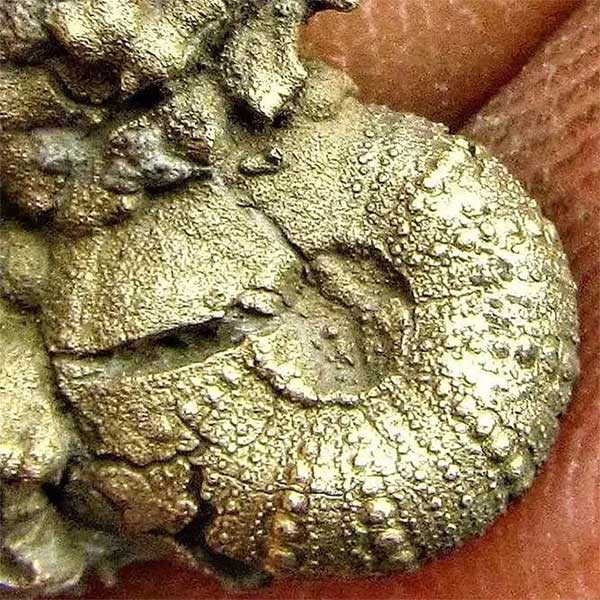
Pyritized sea urchin fossil.
Calcitization
The shells and bones of many animal species contain a significant amount of calcite (CaCO3), but the formation of calcite is not identical to the original shells or bones. Calcium ion-containing aqueous solutions infiltrate the animal’s body, evaporating water, leaving behind calcite crystals or tightly packed calcite, forming beautifully fossilized remains, some resembling white gemstones.
Madagascar ammonite fossils are named so because their complex suture patterns resemble daisies, often cut open to reveal beautiful calcite crystals inside.
Most calcite fossils are gray, light white, gray-brown, or brown due to being mixed with a small amount of clay or other minerals.
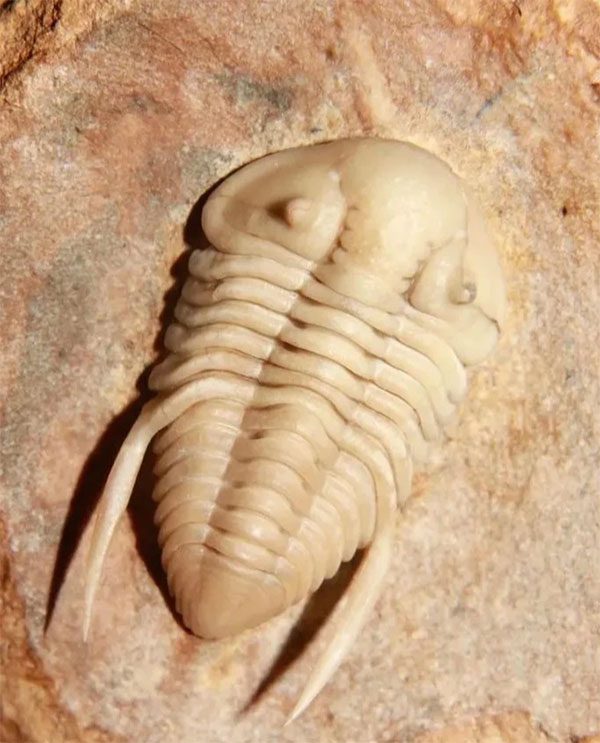
Calcite trilobite.
In addition to the aforementioned mineral infiltration and mineralization, some fossils are created by their own components. For example, colorful ammonites from Canada.
Diverse types of ammonites discovered in Canada today date back 75 to 70 million years. In the shallow seas near present-day Canada, there existed a massive volcano, frequently erupting due to the regular formation of the Rocky Mountains. Each eruption caused the rapid death of most species, including ammonites, burying them beneath the sea floor. Volcanic ash prevented the remains of ammonites from contacting seawater, while the movement of the Earth’s crust introduced abundant iron and magnesium elements into the ammonite remains, eventually transforming them into uniquely colorful fossilized shells over time.
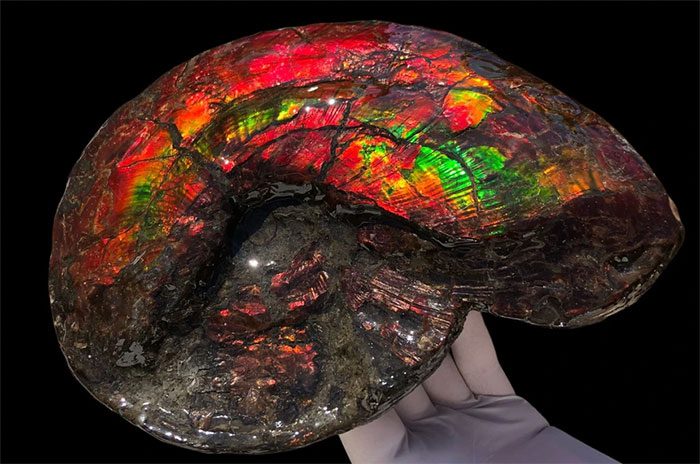
Ammonite fossil.
The stunning iridescence of ammonites arises from the interference colors formed by the reflection of light off its thin layers of aragonite minerals. The thicker the aragonite layers, the more red and green colors develop; conversely, the thinner they are, the more blue and purple hues emerge. Additionally, variations in the content of other mineral components (such as pyrite) in the ammonite shell and the involvement of trace elements also affect its color variations.


















































